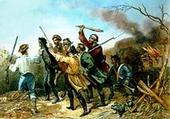President Washington & Alexander Hamilton review the troops raised to surpress the rebellion
receipt for whiskey tax
Whiskey
Whiskey Rebellion
In 1790, the new national government of the United States was attempting to establish itself. Because the government had assumed the debts incurred by the colonies during the Revolution the government was deep in debt. During the 1791 winter session of Congress both houses approved a bill that put an excise tax on all distilled spirits. United States Secretary of the Treasury, Alexander Hamilton, proposed the bill to help prevent the national debt from growing. Loud protests from all districts of the new nation soon followed. These protests were loudest in the western counties of Pennsylvania.
Acceptance of the excise tax varied with the scale of the production; large producers, who produced alcohol as a business venture, were more willing to accept the new tax. They could make an annual tax payment of six cents per gallon. A smaller producer, who only made whiskey occasionally, had to make payments throughout the year at a rate of about nine cents per gallon. Large producers could reduce the cost of the excise tax if they produced even larger quantities. Thus, the new tax gave the large producers a competitive advantage over small producers.
The tax on whiskey was bitterly and fiercely opposed on the frontier from the day it was passed. Western farmers considered it to be both unfair and discriminatory. The excise was only payable in cash, something rare on the western frontier. Also, they had traditionally converted their excess grain into liquor. The whiskey thus produced could easily be transported and sold while the grain itself could not. Since the nature of the tax affected those who sold the whiskey, it directly affected many farmers. Many protest meetings were held, and a situation arose which was reminiscent of the opposition to the Stamp Act of 1765 before the American Revolution.
By the summer of 1794, tensions reached a fevered pitch all along the western frontier as the pioneer/settlers' primary marketable commodity was threatened by the federal taxation measures. Finally the civil protests became an armed rebellion. The first shots were fired at the Oliver Miller Homestead in present day South Park Township Pennsylvania-about ten miles south of Pittsburgh. As word of the rebellion spread across the frontier, a whole series of loosely organized resistance measures were taken, including robbing the mail, stopping court proceedings, and the threat of an assault on Pittsburgh. One group disguised as women, assaulted a tax collector, cropped his hair, coated him with tar and feathers, and stole his horse. Though this did not kill the collector, it scarred him for life.
George Washington and Alexander Hamilton, remembering Shays' Rebellion from just eight years before, decided to make Pennsylvania a testing ground for federal authority. Washington ordered federal marshals to serve court orders requiring the tax protesters to appear in federal district court. On August 7, 1794, Washington invoked Martial Law to summon the militias of Pennsylvania, Virginia and several states. The rebel force they sought was likewise composed of Pennsylvanians, Virginians, and possibly men from other states.
The militia force of 13,000 men was organized, roughly the size of the entire army in the Revolutionary War. Under the personal command of Washington, Hamilton and Revolutionary War hero General Daniel Morgan, the army assembled in Harrisburg and marched into Western Pennsylvania (to what is now Monongahela, Pennsylvania) in October of 1794. The rebels "could never be found," according to Jefferson, but the militia expended considerable effort rounding up 20 prisoners, clearly demonstrating Federalist authority in the national government. The men were imprisoned, where one died, while two were convicted of treason and sentenced to death by hanging. Washington, however, pardoned them on the grounds that one was a "simpleton," and the other, "insane."
Try the BEST MySpace Editor and MySpace Backgrounds at MySpace Toolbox !
